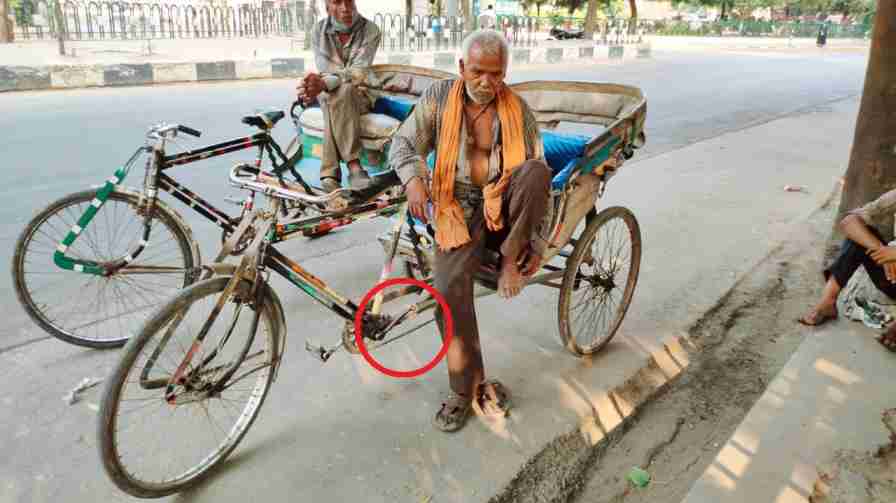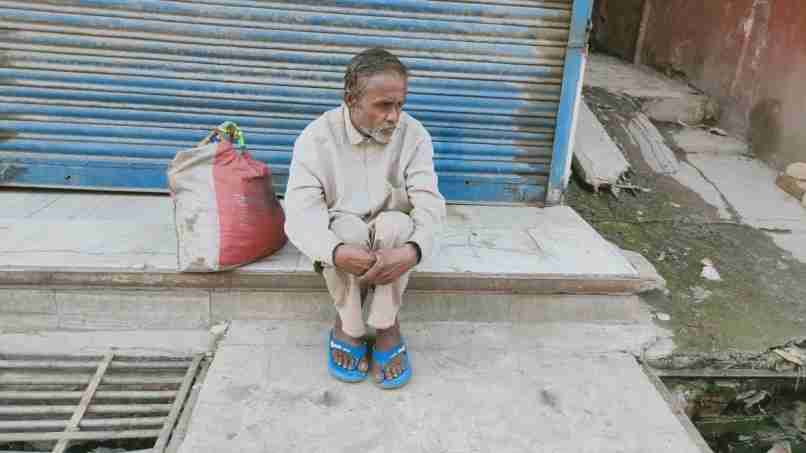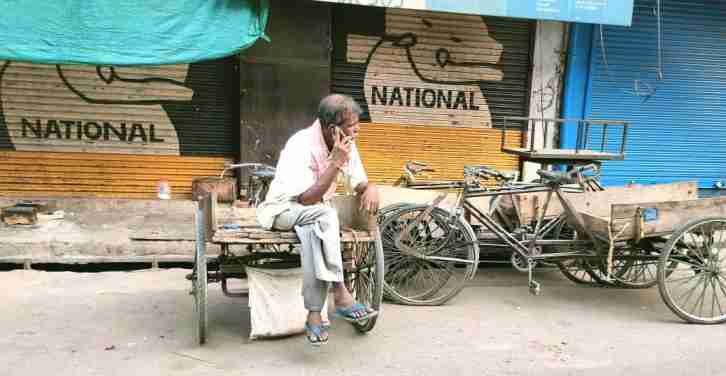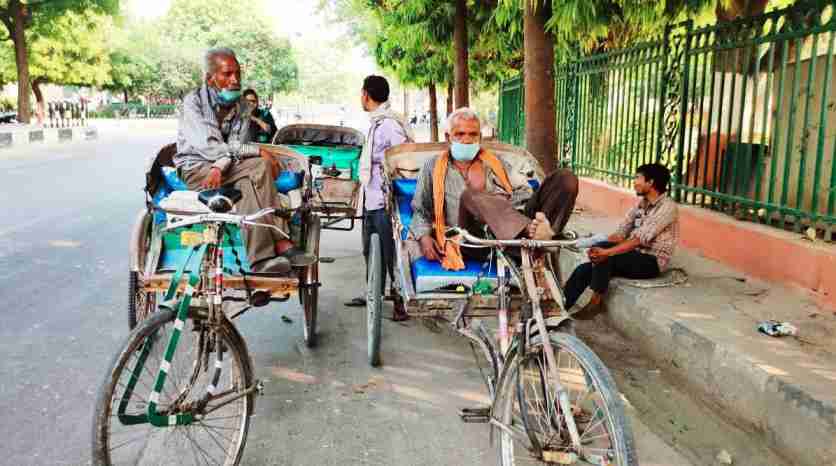COVID19 curbs put the brakes on the livelihood of rickshaw-wallahs
In the second wave of the pandemic, as the lockdown has made a comeback, the livelihoods of autorickshaw, e-rickshaw and the cycle rickshaw drivers in Lucknow, UP have taken a direct hit and often many have to go to bed hungry.

Lucknow, Uttar Pradesh
Rakesh Singh thought he had got lucky and found a savaari (ride) for his cycle rickshaw. He quickly buttoned up his shirt and fixed his face mask in place, all set to pedal away. But when the Gaon Connection reporter told him that he only wanted to speak to Rakesh, the latter looked crestfallen.
“If I get a customer, I can eat that day. Otherwise, I go to bed hungry,” Rakesh, a cycle rickshaw driver in Lucknow, Uttar Pradesh, told Gaon Connection. His cycle had a pedal missing, and Rakesh has been managing with that.
“I have no money to eat, and to repair the pedal will cost me money,” the 50-year-old said. “The day I have more savaaris, I will repair my pedal and cycle home to my brother’s,” added Rakesh, who is from Mal in the rural outskirts of Lucknow, about 45 kilometres away from where he was waiting for that elusive passenger on Parivartan Chowk, near Hazratganj.

Hundreds like Rakesh Singh, who did not or could not return to their homes when the corona curfew was announced is expected to continue till May 24, are now stuck in Lucknow. They have no income nor any means of going back home.
Also Read: The trauma of last lockdown still fresh, migrant workers make a beeline for home

Jobs have dried up
“It has been fifteen days since I worked. I live on the footpath here. I am living off food people give me out of pity,” said Harish Singh, dejected. From Sitapur district, the 45-year-old is a painter in Lucknow. And when that job dried up, he worked as a labourer, pushing handcarts in the city. But since the corona curfew, he has done nothing. “All I hope for now is the lockdown [corona curfew] is lifted and I can go home,” he told Gaon Connection.
A 100 metres away from Harish, Jawaharlal sat on his pushcart near 8-10 other pushcarts, chained together, disused and standing forlorn in front of a shut shop.

“With the market closed, there are no jobs. I used to make at least five hundred to six hundred rupees before the lockdown. Now I barely make anything. The day I do, I get rations from the nearby shop, cook right here on the pavement, and if I don’t earn anything it is hungry to bed for me,” Jawaharlal told Gaon Connection. He said he was not returning home just as yet because he did not want to go empty handed.
Also read: Amid rising COVID19 cases, migrant workers in rural UP anxious about another lockdown
According to data provided by the Centre for Monitoring Indian Economy (CMIE), an independent think tank, because of the lockdown, this year, up to April, 7.5 million people have lost their jobs in the organised and the unorganised sectors.
In September 2020, the central government said in the Lok Sabha that in the nationwide lockdown of 2020, about 10.5 million migrant labourers returned home. The highest number to come home was in Uttar Pradesh (3,249,638). This was followed by Bihar (1,500,612).
Second wave and corona curfew
The second wave has wreaked havoc in livelihoods, especially in the unorganised sector. Those who could, got back home, those who couldn’t, are miserable in their cities of work. But in both the cases livelihoods have been lost and they are staring at hunger and poverty in the face.
Also Read: Preyed on by the pandemic

“The impact of the lockdown has been even greater with the second wave of the pandemic,” Nivedita Jairam of Asian Floor Wage Alliance (a labour led global labour and social alliance across garment producing countries), told Gaon Connection.
“When we speak to the labourers, it is obvious that no lessons have been learnt from last year’s experience. Everyone knows that without work, the labourers will struggle to survive,” Jairam pointed out. Ever since the last lockdown, the daily wagers and labourers are sunk in debts taken in order to make ends meet, she added.
Second year running, the cycle rickshaw drivers, who fall through the cracks and never make it to any database, are struggling to survive.
Last year, between May 30 and July 16, Gaon Connection conducted a nationwide survey to understand the impact of the COVID-19 on rural India and how people managed their livelihood in the pandemic.
Also Read: During lockdown, rural India faced insurmountable sufferings; 74% satisfied with government
The survey revealed that nine out of ten people (89 per cent) suffered financial stress because of the lockdown. Seventy eight per cent of the respondents had no job, and 71 per cent of the respondents said their income was reduced. Twenty three per cent of the respondents said they had to take loans in order to run their households.
Similar situation seems to be prevailing now as the lockdown like restriction returns. “Most of us do not own rickshaws. We hire them at forty rupees a day,” Sumeri, a cycle rickshaw driver for 20 years, told Gaon Connection.
Outside the historic Bara Imambara, on a scorching afternoon, a lone e-rickshaw moved slowly on the near empty road, hoping to spot a customer.

Also Read: 80% rural respondents said their work was affected due to the lockdown
“Usually I earn up to six hundred rupees a day, but for the past twenty days or so, I have barely earned anything,” Mohammad Jubair told Gaon Connection. He has to pay Rs 370 as daily rent for the e-rickshaw he plies.
Demand for relief
“I go to the subzi mandi in the morning and sometimes manage to find some work that gets me about hundred and fifty rupees a day. I give part of it to the rickshaw owner, and the rest I use to buy food,” he said.
“In Lucknow alone there are nearly fifty thousand auto, tempo and e-rickshaw drivers without a job,” Pankaj Dixit, president of Lucknow’s auto rickshaw and three-wheeler union (cycle rickshaw drivers are not part of the union), told Gaon Connection.
These auto and tempo drivers have no savings and whatever little they had is exhausted in the lockdown, Dixit said. “Many of them are seen outside during the lockdown despite the fear of the police coming down on them. Still, they live in hope they will get a ride,” he said.
Also Read: One in five rural households sold or mortgaged land, jewellery or valuables during the lockdown
Last year, the state government had sanctioned a three time payment of Rs 1,000 each for the three-wheeler drivers which helped them out in the dire times, said Dixit. “This time we are asking the government to pay us a one time relief of five thousand rupees along with two-month rations,” Dixit told Gaon Connection. “At least we will not go hungry,” he added.
On May 16, Chief Minister Yogi Adityanath tweeted that the Uttar Pradesh government was responsible for its citizens and their livelihood. He announced that the poorer sections would get a cost of living allowance of Rs 1,000 a month. Nearly a crore of people will benefit from this, the chief minister said.
The beneficiaries would include daily wagers, pushcart vendors, pavement shopkeepers, barbers, cobblers, etc.
Read the story in Hindi.

